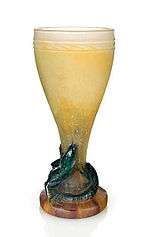Amalric Walter


Victor Amalric Walter (born Sèvres in 1870 - died at Lury-sur-Arnon in 1959) was a French glass maker mainly known for his pâtes de verre pieces.
Biography
He first worked at the Manufacture nationale de Sèvres, near Paris, where he decorated and glazed earthenware pieces. He won an award at the 1900 World's Fair. There, he was probably impressed by the pâtes de verre of Damousse and Décorchemont who were also awarded.
He then decided to work for the Cristalleries Daum at Nancy, France, from 1904 or 1905, where he stayed until the first World War in 1915. There, he met a designer/modelist, Henri Bergé, with whom he made pâtes de verre always signed "Daum Nancy", without his name nor Bergé's name. With his help, he cast around 100 different models; but few of these pieces from this period were preserved so far.
After the war, he decided to create his own glass studio at Nancy, rue Claudot. He continued his collaboration with Henri Bergé. From 1919 to 1935 with Bergé and other famous sculptors or designers, he cast not less than 500 models, always in few numbers due to the sophisticated technique of glass kiln casting. It is said that when he was not happy about pieces that came out from the kiln, he used to throw them onto the outside wall of his studio, saying he was a genuine perfectionist. His staff was not numerous (8-10 workers maximum).
Art Deco began to replace Art Nouveau, and arts and crafts production or small business sector became non-competitive due to high manufacturing costs. He then reoriented his production and cast more simple pâtes de verre, clearly influenced by the art deco design.
After 1935, his workshop definitively closed. He also progressively became blind.
He died in 1959, blind, in destitution at Lury-sur-Arnon where he came to visit a friend.
Research
Few researchers studied Walter's work and unique kiln casting process.[1] A scientific program was launched by Dr.Keith CUMMINGS and Dr.Max STEWART, in Dudley, in 2006, named the Amalric Walter Research Project, at the same time that was held an exhibition on Walter's pâtes de verre at the Broadfield House Glass Museum. This project was a major step in understanding of pâtes de verre kiln casting process.
Influences
Walter was influenced by Art Nouveau and the Art Deco.
He continued to cast naturalist pieces during the art deco period, but due to manufacturing cost and the changing tastes and because of the 1929 Great Depression that also affected Europe and France, his production became more insipid with fewer colors. Most of his pieces of the later art deco period are mono/bi/trichromic and much more synthetic, with the aim to be more affordable.
References
- ↑ J.Kervin & D.Fenton, "Pâte de Verre and Kiln Casting of Glass", GlassWare Studios, First ed., 1997